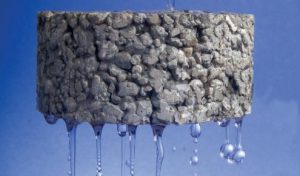What is Composite
Porous Concrete
Pervious Concrete
Pervious concrete (also called porous concrete, permeable concrete, no fines concrete and porous pavement) is a special type of concrete with a high porosity used for concrete flatwork applications that allows water from precipitation and other sources to pass directly through, thereby reducing the runoff from a site and allowing groundwater recharge.
Pervious concrete is made using large aggregates with little to no fine aggregates. The concrete paste then coats the aggregates and allows water to pass through the concrete slab. Pervious concrete is traditionally used in parking areas, areas with light traffic, residential streets, pedestrian walkways, and greenhouses. It is an important application for sustainable construction and is one of many low impact development techniques used by builders to protect water quality.
Materials in Pervious Concrete
Pervious concrete, mainly consists of the usual Portland cement, water and coarse aggregates (either single-sized coarse or grading between 19 and 9.5 mm). It also contains a paste to fill the voids. These ingredients give concrete a porosity of 15 to 35%. Typical Pervious concrete mix designs used in the United States consists of cement, single-sized coarse aggregate, and a water to cement ratio ranging from 0.27 to 0.43 (Ravindrarajah and Yukari, 2010).
Pervious concrete can be made without chemical admixtures, but it is not uncommon to find several types of chemical admixtures added to influence the performance in a favourable manner (Tennis et al., 2004;Obla, 2007; Cheng et al., 2011). Moreover, it is possible to change in the mix design for pervious concrete to allow the use of recycled concrete as aggregates and industrial wastes, e.g. silica fume (Gupta and Kim, 2013).
Advantages Using Pervious Concrete
Eliminating the high cost of underground piping systems.
Helping healthy tree growth without breaking pavement surfaces since it allows water, air and nutrients to pass to tree roots.
Increasing the quantity of water retained on site and penetrates into aquifers thus promoting healthy water levels which sustain our streams and drinking water.
Eliminating the expense of curbs and gutters while making sites more handicap accessible.
Preventing pollutants from reaching watercourses which frequently occur with regular storm water systems during heavy rainfall events.
Reducing the heat island effect common with development in urban areas when conventional pavement systems are utilized.
The use of pervious concrete may lead to reduce storm water pollution at the source, eliminate or reduce the size of storm sewers, and control storm water runoff.
According to Tennis et al (2004), pervious concrete play a noticeable role in reducing noise , minimizing the heat island effect in large cities, and improving skid resistance.



